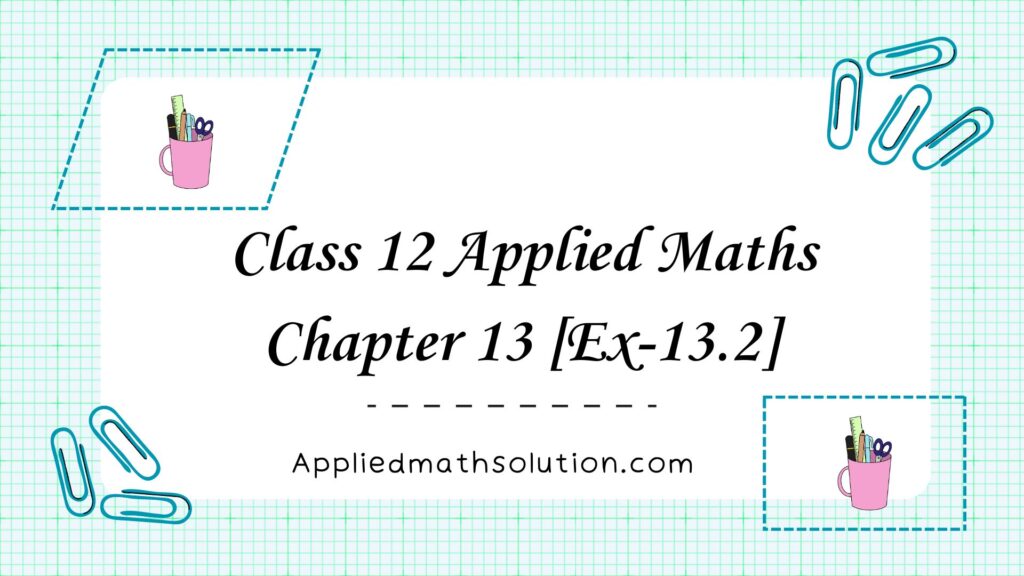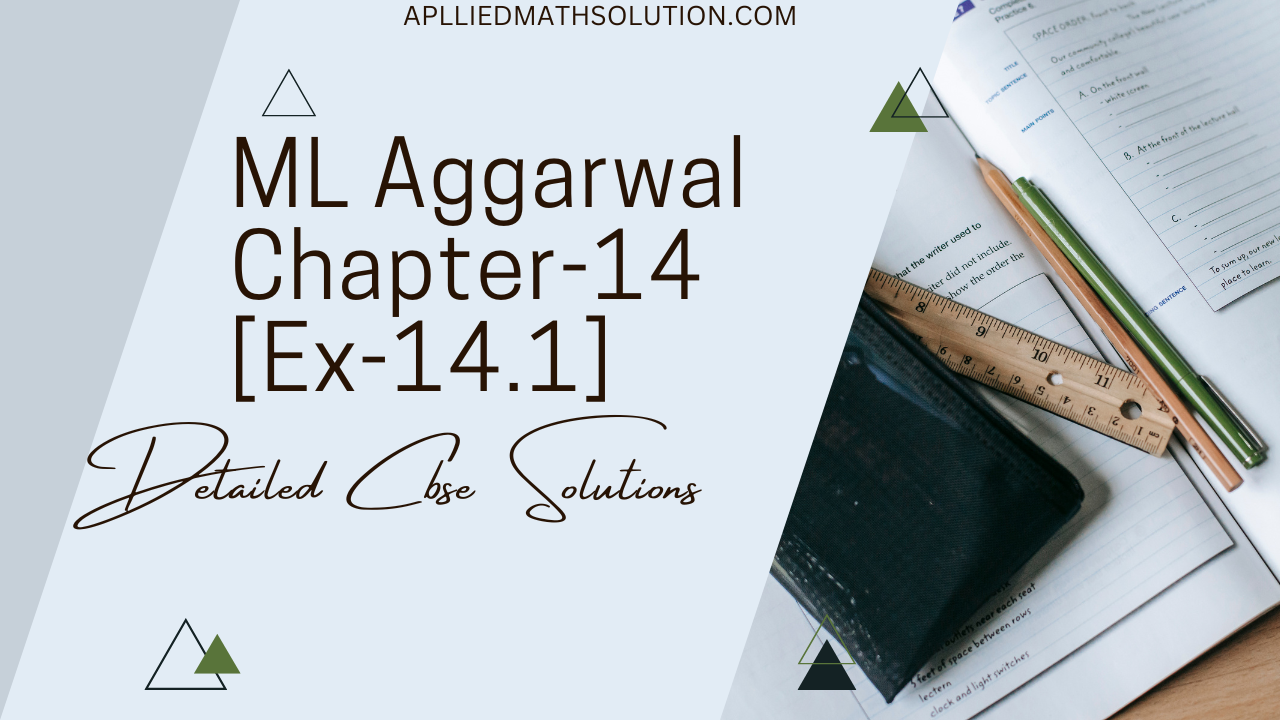Welcome to Class 12 Applied Maths Chapter 13, where we embark on an exciting journey into the world of advanced mathematical concepts tailored for Class 11 students.” Unlock the power of applied mathematics with expert solutions crafted by professionals at AppliedMath.com. Designed to propel students towards academic success, our meticulously curated ML Aggarwal Solutions for Applied Mathematics cater to Class 11 and class 12 students seeking mastery in their examinations. Every query from the CBSE ML Aggarwal Books finds a comprehensive answer on our platform, complete with detailed explanations and step-by-step solutions presented in an easily understandable language.
Dive into the world of applied mathematics and discover how our resources can elevate your understanding and performance. Keep reading to explore the wealth of ML Aggarwal Solutions for Class 11 and Class 12 Applied Mathematics.
Here we provide you with Class 12 Applied Maths Chapter 13, to help you gain a comprehensive understanding of the chapter and its concepts. https://appliedmathsolution.com/wp-admin/post.php?post=6&action=edit

Class 12 Applied Maths Chapter 13 Solutions
Return, Growth And Depreciation
EXERCISE- 13.2
Q.1 Find the effective rate of return which is equivalent to a stated rate of 8% compounded quarterly. [Use (1.02)^4 = 1.0824]
Ans. r = 8%, p = 4
E = (1 + r/100p)^p – 1
= [1 + 8/(100×4)]^4 – 1
= (1 + 0.02)^4 – 1
= (1.02)^4 – 1
= 1.0824 – 1
= 0.0824
= 8.24%
Q.2 Find the declared rate of return compounded semiannually which is equivalent to 6% effective rate of return. [Use (1.06)^1/2 = 1.0296]
Ans. r = ?, E = 6%, p = 2
E = (1 + r/100p)^p – 1
6/100 = [1 + r/(100×2)]^2 – 1
0.06 + 1 = (1 + r/200)^2
1.06 = (1 + r/200)^2
(1.06)^1/2 = 1 + r/200
1.0296 = 1 + r/200
0.0296 = r/200
r = 5.9200
r = 5.92%
Q.3 Find the effective rate which is equivalent to nominal rate of 10% p.a. compounded monthly.
[Given that: (1.00833)^12 = 1.1047]
Ans. r = 10%, p = 12
E = (1 + r/100p)^p – 1
= [1 + 10/(100×12)]^12 – 1
= (1 + 0.00833)^12 – 1
= (1.00833)^12 – 1
= 1.1047 – 1
= 0.1047
= 10.47%
Q.4 Find the effective rate of return equivalent to declared rate of 12% compounded
(i) semiannually
(ii) quarterly
(iii) monthly
(iv) continuously
[Use (1.06)^2 = 1.1236, (1.03)^4 = 1.1255 and (1.01)^12 = 1.1268, e^0.12 = 1.1275]
Ans. (i) p = 2
E = (1 + r/100p)^p – 1
= [1 + 12/(100×2)]^2 – 1
= (1 + 0.06)^2 – 1
= 1.1236 – 1
= 0.1236
= 12.36%
(ii) p = 4
E = (1 + r/100p)^p – 1
= [1 + 12/(100×4)]^4 – 1
= (1.03)^4 – 1
= 1.1255 – 1
= 0.1255
= 12.55%
(iii) p = 12
E = (1 + r/100p)^p – 1
= [1 + 12/(100×12)]^12 – 1
= (1.01)^12 – 1
= 1.1268 – 1
= 0.1268
= 12.68%
(iv) = e^r – 1
= e^0.12 – 1
= 1.1275 – 1
= 0.1275
= 12.75%
Q.5 Mrs. Renu has two investment options 8.4% p.a. compounded monthly or 8.5% p.a. compounded semiannually. Which option is better for Mrs. Renu?
[Use (1.007)^12 = 1.0873, (1.0425)^2 = 1.0868]
Ans. Option I :
E = (1 + r/100p)^p – 1
= [1 + 8.4/(100×12)]^12 – 1
= (1 + 0.07)^12 – 1
= 1.0873 – 1
= 0.0873
= 8.73%
Option II :
E = (1 + r/100p)^p – 1
= [1 + 8.5/(100×2)]^2 – 1
= (1 + 0.0425)^2 – 1
= 1.0868 – 1
= 0.0868
= 8.68%
Therefore, Option I is better.
Q.6 Mr Deepanshu wants to make an investment of Rs.10000 for 5 years. He has two options. First option fetches him a return of 8% compounded semiannually and second option fetches him go for? a return of 7.5% compounded quarterly. Which investment option should he [Use (1.04)^2 = 1.0816 and (1.01875)^4 = 1.0771]
Ans. Option I :
E = (1 + r/100p)^p – 1
= [1 + 8/(100×2)]^2 – 1
= (1 + 0.04)^2 – 1
= 1.0816 – 1
= 0.0816
= 8.16%
Option II :
E = (1 + r/100p)^p – 1
= [1 + 7.5/(100×4)]^4 – 1
= (1 + 0.01875)^4 – 1
= 1.0771 – 1
= 0.0771
= 7.71%
Therefore, Option I is better.
Q.7 Mrs. Vandana invested Rs.35000 in a shares of a company and reinvested the earnings every year in buying the shares of the same company. At the end of 5 years, the value of shares increased to Rs.56000. Calculate the compound annual growth rate of her investment.
Ans. FV = Rs.56000, PV = Rs.35000, n = 5
CAGR = (FV/PV)^1/n – 1
= (56000/35000)^1/5 – 1
= (1.6)^1/5 – 1
= 1.098 – 1
= 0.098
= 9.8%
Q.8 Mr Mohan invested ₹5000 in a fund at the beginning of year 2018 and by the end of year 2018 his investment was worth ₹9000. Next year market crashed and he lost ₹3000 and ending up with 16000 at the end of year 2019. Next year i.e. 2020 he gained ₹4500 and ending up with 10500 at the end of the year. Find CAGR of his investment.
Ans. PV = Rs.5000, FV= Rs.10500, n = 3
CAGR = (FV/PV)^1/n – 1
= (10500/5000)^1/3 – 1
= (2.1)^1/3 – 1
= 1.280 – 1
= 0.280
= 28%
Q.9 Bhandari invested Rs.10000 in a portfolio with return given below:
From April 1, 2012 to March 31, 2013 portfolio grew to ₹12000
From April 1, 2013 to March 31, 2014 portfolio grew to Rs.12500
From April 1, 2014 to March 31, 2015 portfolio grew to ₹13800
On March 31, 2016 the portfolio ended with Rs.18000
Calculate the compound annual growth rate of portfolio.
Ans. PV = Rs.10000, FV= Rs.18000, n = 4
CAGR = (FV/PV)^1/n – 1
= (18000/10000)^1/4 – 1
= (1.8)^1/4 – 1
= 1.158 – 1
= 0.158
= 15.8%
Q.10 Mr Tripathi invested Rs.10000 in a company’s fund. His yearly investment values are shown in the table given below:
| Year | 0 | 1 | 2 | 3 |
| Amount (in Rs.) | 10000 | 13000 | 11000 | 9400 |
Calculate CAGR his investment.
Ans. FV = Rs.9400, PV= Rs.10000, n = 3
CAGR = (FV/PV)^1/n – 1
= (9400/10000)^1/3 – 1
= (0.94)^1/3 – 1
= 0.9795 – 1
= -0.0205
= -2.05%
Q.11 Mr Kumar has invested Rs.20000 in year 2014 for 5 years. If CAGR for that investment turned out to be 11.84%. What will be the end balance?
Ans. FV = ?, PV= Rs.20000, n = 5, CAGR = 11.84%
CAGR = (FV/PV)^1/n – 1
11.84/100 = (FV/20000)^1/5 – 1
0.1184 + 1 = (FV/20000)^1/5
1.1184 = (FV/20000)^1/5
(1.1184)^5 = FV/20000
1.75 = FV/20000
FV = 35000
Q.12 Mr Naresh has bought Rs.200 shares of city look company at 100 each in 2015. After selling them he has received ₹30000 which accounts for 22.47% CAGR. Calculate the number of years for which he was holding the shares.
Ans. FV = Rs.30000, PV= 200 x 100 = 20000, CAGR = 22.47%
CAGR = (FV/PV)^1/n – 1
22.47/100 = (30000/20000)^1/n – 1
0.2247 + 1 = (1.5)^1/n
1.2247 = (1.5)^1/n
Taking log on both sides
log(1.2247) = log(1.5)^1/n
log(1.2247) = 1/n log(1.5)
0.0881 = 1/n x 0.1761
n = 0.1761/0.0881
= 1761/881
= 1.99
= 2 years
Q.13 A start-up company invested Rs.3,00,000 in shares for 5 years. The value of this investment was Rs.3,50,000 at the end of second year, 3,80,000 at the end of third year and on maturity, the final value stood at ₹4,50,000. Calculate the compound Annual Growth Rate (CAGR) on the investment.
[Given that: (1.5)^5 = 1.084]
Ans. FV = Rs.450000, PV= Rs.300000, n = 5
CAGR = (FV/PV)^1/n – 1
= (450000/300000)^1/3 – 1
= (1.5)^1/5 – 1
= 1.084 – 1
= 0.084
= 8.4%
FAQ’s related to Class 12 Applied Maths Chapter 12 on Return, Growth And Depreciation:
Q.1 What is the concept of “Return” in finance?
Ans. In finance, “Return” refers to the profit or loss derived from an investment over a particular period. It is typically expressed as a percentage of the original investment amount. Returns can be in the form of interest, dividends, capital gains, or any other form of financial gain from an investment.
Q.2 What is “Depreciation,” and why is it important?
Ans. Depreciation is the process of allocating the cost of a tangible asset over its useful life. It represents the wear and tear, deterioration, or obsolescence of an asset. Depreciation is important for accounting and tax purposes as it helps businesses allocate costs and manage their financial statements by reducing the value of assets over time.
Q.3 What are the common methods of calculating depreciation?
Ans.
- Straight-Line Method: This method spreads the cost of the asset evenly over its useful life. The formula is:
Depreciation Expense = (Cost of Asset − Salvage Value)/Useful Life
- Declining Balance Method: This method applies a constant rate of depreciation to the reducing book value of the asset each year.
Q.4 How does inflation affect returns and growth?
Ans. Inflation reduces the purchasing power of money, which can affect the real returns and growth of investments. If the inflation rate is higher than the nominal return on an investment, the real return could be negative, meaning the investor’s purchasing power decreases despite earning nominal returns.
These are a few Frequently Asked Questions relating to Class 12 Applied Maths Chapter 13
In Class 12 Applied Maths chapter 13, you will explore fascinating topics that form the backbone of practical problem-solving techniques. Through clear explanations, illustrative examples, and step-by-step solutions, you’ll grasp complex concepts effortlessly. Whether you’re preparing for exams or simply eager to deepen your mathematical understanding, Class 12 Applied Maths Chapter 13 promises an enriching learning experience that will set you on the path to success. Class 12 Applied Maths Chapter 13, we delve deep into advanced mathematical concepts that are crucial for understanding.



Thank you didi 👑
I’m still learning from you, while I’m improving myself. I definitely enjoy reading everything that is written on your website.Keep the information coming. I loved it!